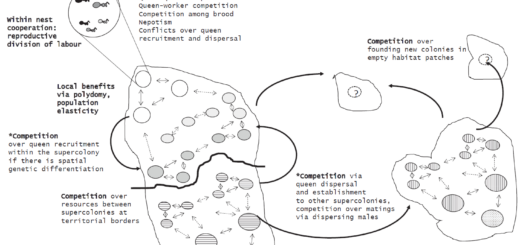Ant research in the genomic era: advances and prospects
In the recently published review paper “Genes and genomic processes underpinning the social lives of ants” in Current Opinion in Insect Sciene (2018), Emeline Favreau, Carlos Martínzez-Ruiz, Leandro Rodrigues Santiago, Robert Hammond, and Yannick Wurm revise recent insights obtained by using various genomic approaches. Find here a discussion of the paper.
A Review compiled by Jessica Purcell 
Sequencing costs are declining at an astonishing rate, opening the door for the rapid expansion of genomic studies on a wide array of non-model organisms. A recent article by Favreau & al. (2018) provides a nice overview on the current state of genomic research focused on ants. As the article reveals, the number of published ant genomes and transcriptomes has proliferated in the last few years, facilitating detailed comparative, population, and functional genomic studies. The authors summarize advances on topics including differentiation of distinct female castes, genetic architecture underlying colony social organization, longevity, mechanisms facilitating symbioses, and the role of chemical communication genes in colonies. While Favreau & al. (2018) concisely review much of the recent work on these topics, they do not devote much space to suggesting future directions in each area. There is still so much more to learn about the genetic underpinnings of these unique traits of ants, and the coming years should hold some exciting new discoveries.
Within studies of ants and beyond, there are several issues that limit the inferences that can be made from current data. Transcriptomic studies, for example, often identify genes with differential expression between alternative groups, such as queen and worker castes. However, moving beyond volcano plots to examine networks of interacting genes (Morandin & al. 2016) and to perform experiments to validate gene function (e.g., Friedman & al. 2017) will be important ways to further understand how genes shape phenotypes. Favreau & al. (2018) lay out new developments in both of these areas that will improve our ability to test the role of candidate genes. One of the major challenges still ahead for most ant species will be to establish successful transgenic methods. This may prove to be challenging in species that are difficult to maintain in a lab environment, but some species such as clonal raider ants are proving amenable to genetic manipulation (Trible & al. 2017).
Genome-wide association studies seeking genetic regions underlying alternative social organization have similarly contributed a useful starting point, but further research is essential to illuminate causal links between genotype and phenotype. Favreau & al. (2018) point out the importance of investigating whether similar genes and genomic architecture underlie social polymorphisms in species beyond Solenopsis invicta (see Wang & al. 2013) and Formica selysi (see Purcell & al. 2014). In addition to expanding the phylogenetic representation in studies of this type, researchers should invest in exploring how known supergenes evolve, explicitly linking supergene genotypes to traits associated with ant fitness, and understanding how polymorphisms in nest founding strategy or colony queen number persist at both the genetic and phenotypic level.
Genomics will also open new research avenues for other novel ant behaviors and dynamics. For example, Favreau & al. (2018) point out that social parasitism is widespread in ants, and identifying the genetic mechanisms underlying the emergence of different forms of parasitism (e.g., dulosis, inquilinism) will enhance our current understanding of the phenotypic and genetic changes that accompany and reinforce this evolutionary transition. This research area will be strengthened by parallel studies investigating the independent origin of similar behavioral syndromes in different phylogenetic clades. How queens allocate reproduction in polygynous or polyandrous nests is another long-standing question that could be better addressed with new genomic techniques. In some species, certain mate pairings are more likely to yield sexual offspring than others (Schwander & Keller 2008). With genomic tools, we may be able to detect and test loci underlying such patterns. Overall, this is a tremendously exciting time to be studying social insects in general, and ants in particular. In the next few years, the number of genomic resources for novel ant species will continue to proliferate through the work of individual labs and through consortia like the Global Ant Genomics Alliance (GAGA), allowing researchers to return to old questions with better tools and to formulate new ones.
References
Favreau, E., Martinez-Ruiz, C., Santiago, L.R., Hammond, R.L. & Wurm, Y. 2018: Genes and genomic processes underpinning the social lives of ants. – Current Opinion in Insect Science 25: 83-90.
Friedman, D.A., Gordon, D.M. & Luo, L.Q. 2017: The mutAnts are here. – Cell 170: 601-602.
Morandin, C., Tin, M.M.Y., Abril, S., Gomez, C., Pontieri, L., Schiott, M., Sundstrom, L., Tsuji, K., Pedersen, J.S., Helantera, H. & Mikheyev, A.S. 2016: Comparative transcriptomics reveals the conserved building blocks involved in parallel evolution of diverse phenotypic traits in ants. – Genome Biology 17: art. 43.
Purcell, J., Brelsford, A., Wurm, Y., Perrin, N. & Chapuisat, M. 2014: Convergent genetic architecture underlies social organization in ants. – Current Biology 24: 2728-2732.
Schwander, T. & Keller, L. 2008: Genetic compatibility affects queen and worker caste determination. – Science 322: 552.
Trible, W., Olivos-Cisneros, L., Mckenzie, S.K., Saragosti, J., Chang, N.C., Matthews, B.J., Oxley, P.R. & Kronauer, D.J.C. 2017: orco mutagenesis causes loss of antennal lobe glomeruli and impaired social behavior in ants. – Cell 170: 727-735.
Wang, J., Wurm, Y., Nipitwattanaphon, M., Riba-Grognuz, O., Huang, Y.C., Shoemaker, D. & Keller, L. 2013: A Y-like social chromosome causes alternative colony organization in fire ants. – Nature 493: 664-668.
Featured image: Icon made by dDara from www.flaticon.com is licensed by Creative Commons BY 3.0





Thanks v much Jessica (& Myrmecological News!) for the review and further thoughts – fully agree with all points you make!
Yannick